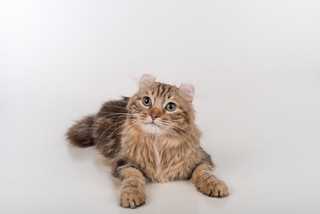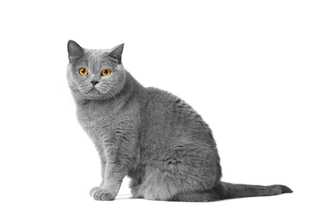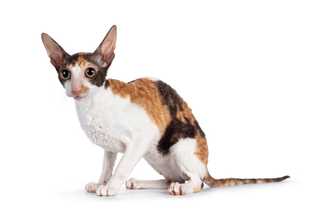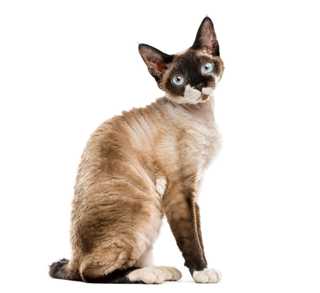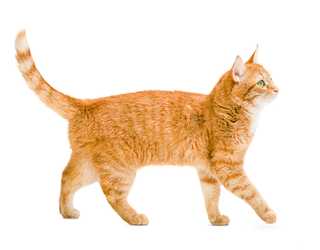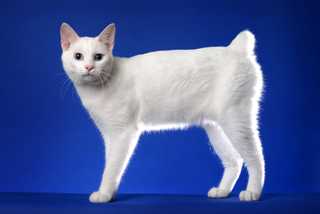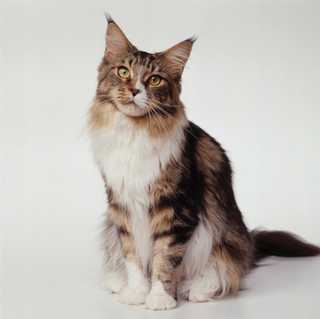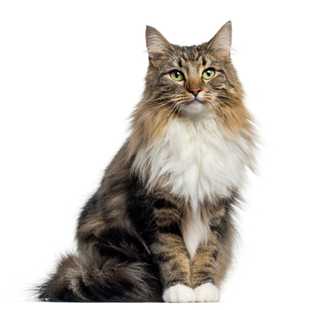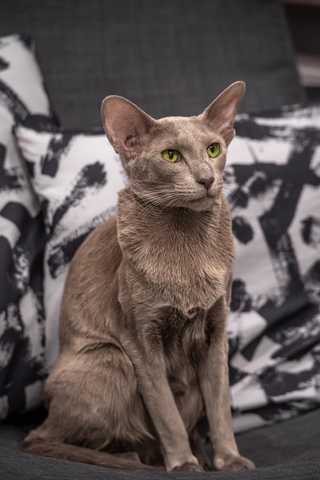
Note: While the breeds in this collection tend to be White, individual pets will vary. Please consult the adoption organization for details on a specific pet.
There are many breeds that include a white cat, from the British Shorthair and Sphynx to the Turkish Van. While many pet parents want to claim their cat falls into the rare, colorless category, a true white cat is defined by the lack of melanin pigmentation – the gene that gives her coat and eyes color.
As little as 5% of the total, general cat population can be called a truly white breed of cat but for most white cat lovers, definitions pale in comparison to their kitty’s amazing personalities, distinct features, and quirky antics.
If a white fluffy cat, white long-haired cat, shorthaired cat or hairless kitty is your first choice for adoption, then check out the list of colored breeds that produce all black and white kittens too. Learn about the special needs of these milk-colored mousers, and whether a white cat is right for you.
1. American Curl
These playful and energetic kitties love being part of a family, especially if there are children in the household. American Curls will settle into a warm lap without an invitation, enjoy being perched on their favorite person’s shoulders or offer a light pat on your face and a loving nuzzle to ensure she is receiving the love she deserves.
Best known for: Whimsical, curled ears
2. American Shorthair
Purrrfect in every way from her medium energy level to her just-the-right-size to fit in anywhere – it’s no wonder the American Shorthair has earned the expression “happy medium.” She’s an all-rounder for a family who is as content and consistent as she is.
Best known for: Quiet and stealthy demeanor, which excites her natural instinct to play hunting games.
3. British Shorthair
Maintaining her low-profile attitude means the British Shorthair is not an in-your-face kind of cat but rather prefers to appear at the exact right time to share a moment. She bonds to all family members equally so no one feels left out!
Best known for: Sweet, round, massive face and head.
4. Cornish Rex
With her endearing mannerisms, the highly sociable and always active Cornish Rex isn’t too shy to steal food off your plate, retrieve objects for a game of fetch or show you that she can jump to the highest cabinet in the house. Her kitten-like antics keep the whole family entertained.
Best known for: Tight, silky, wavy fur coat.
5. Devon Rex
From cat-liker to cat-obsessed – that’s how quickly you’d fall in love with the Devon Rex, and she’d return it tenfold. Her involvement in life around her will keep her close to whatever you’re doing – reaching for a plate from a cabinet or checking into your social media.
Best known for: Jumbo-sized, elephant-like ears and missing whiskers.
6. Japanese Bobtail
Japanese Bobtails know how to keep the conversation going. Expect most of her responses to be chirps that show off her wide range of tones – almost sounding like singing. With a Bobtail, you’ll always have a friend to talk to.
Best known for: 4” pom-pom tail that curls into a corkscrew shape.
7. Maine Coon
This ship-faring sailor maintains her love for travel and is easy to leash train, so she can join all your adventures. Whether her family is planning a road trip, air trip or just an outdoor walk – Maine Coons are happy to share in a family’s active lifestyles.
Best known for: Antennae-like tufted ears.
8. Norwegian Forest Cat
With eyes that match the color of the greenest forest canopy, this cold weather fluffy is a natural detective. She needs a closer look at everything – a skill the Norwegian Forest Cat may have picked up during her wild last life in the forests of Norway.
Best known for: Emerald green eyes and detective skills.
9. Oriental
With ears so large, the Oriental can pick up even the quietest noises, ensuring she is first on the scene to investigate. Her curiosity to discover the world around her means she is always on the go but will stop everything for some love and affection from the one person she is bonded to.
Best known for: Flaring, satellite-dish ears and almond-shaped face and eyes.
10. Persian
No one can deny the glamour and charm of meeting a Persian. And once you have earned her love and trust, you’ll need to be as committed to her as she is to you – starting with maintaining her long, silky coat. A Persian always has time to be fussed over and pampered.
Best known for: Magnificent long coat.
11. Scottish Fold
The doe-eyed, round faced Scottish Fold makes a great companion for the one person she makes her own. She loves nothing more than being near you, not on you, and will immediately jump into a game of fetch if you’re up for some playtime activity.
Best known for: Forward-folded ears.
12. Siberian
Siberians are built for survival to get through the harshest Russian winters. Her large, robust body is covered in a thick undercoat with water-resistant fur. She has the ability to scale the highest surfaces and problem solving skills to help her up there. Siberians are, quite simply, fearless.
Best known for: Fascination with water, dropping toys into her water bowl to fish out.
13. Sphynx
Charmingly graceful, a Sphynx enjoys nothing more that showing off her flamboyant, monkey-like acrobatics. She is easily able to display her skill from the highest shelf in a closet to a blind corner you’d never expect her to come from. This kitty deserves nothing less than your full attention for her great performances. Reward her with the devotion she deserves.
Best known for: Wrinkly bare skin, large, helicopter ears and her dog tail wagging skill.
14. Turkish Angora
Almost as if she is in a world of her own, the Turkish Angora takes play to a whole other level. She can spend her hours chasing sunbeams or enjoy an occasional plunge into the bath for a swim. She’s well known to pounce unexpectedly from under your bed too. A Turkish Angora is totally content amusing herself and she does it with the poise of a dancer.
Best known for: Swimming expertise.
15. Turkish Van
You’ll never be bored if a Turkish Van is part of your family. She’s highly active, entertaining and energetic, testing her balancing skills on the slimmest, highest platforms, running, jumping and plunging into the pool or dropping toys into a full sink so she can dive in and scoop them out.
Best known for: Swimming prowess.
Which types of white cats are there?
Even white cat breeds have a variety of white types to choose from. Some cats are white due to being born with little or no melanin pigmentation.
Melanin is the gene mechanism that produces color and without it, a cat’s coat will be white and the skin and eyes will be colorless. There are three gene mutations that are known to produce a white kitten:
- Albino gene, or Albino White cat breeds are born with no melanin pigmentation. This is an extremely rare cat and most white cats are not classified as albino. A true Albino White has pale red/pink eyes and skin coloring.Albinism is not connected to deafness.
- Piebald gene, also known as Complete White Spotting occurs when a cat carries a dominant spotting gene which covers the coat in all white. If the spotting factor is incomplete, the white kitten will grow to be a spotted black and white cat.White spotting is not linked to being deaf.
- Epistatic gene, commonly referred to as Dominant White, is the gene that produces white cats with blue, orange or odd color eyes and this mutation is most closely related to deafness.These cats will have hearing loss on the same side that she has a blue eye.
-->
| 1 | 2 | 3 |
|---|---|---|
| Albino gene or Albino White cat breeds are born with no melanin pigmentation. This is an extremely rare cat and most white cats are not classified as albino. A true Albino White has pale red/pink eyes and skin coloring. Albinism is not connected to deafness. | Piebald gene, also known as Complete White Spotting occurs when a cat carries a dominant spotting gene which covers the coat in all white. If the spotting factor is incomplete, the white kitten will grow to be a spotted black and white cat. White spotting is not linked to being deaf. | Epistatic gene, commonly referred to as Dominant White, is the gene that produces white cats with blue, orange or odd color eyes and this mutation is most closely related to deafness. These cats will have hearing loss on the same side that she has a blue eye. |
White cat facts
- 5% of the cat population includes pure whites.
- 15% – 40% of the 5% have one or both eyes that are blue.
- 60% – 80% of the fully white cats with one or both blue eyes are likely deaf.
- 60% – 80% of the 5% have orange or green eyes and 20% of them are deaf.
How to care for a white cat breed
All pets, just like humans, will eventually have some health issues. Like any condition, a white cat’s health is completely manageable given pet parents have all the information to make informed decisions.
Blindness in white cat breeds
There is no truth that white cats with blue eyes are blind. Solid white cats with blue eyes are often deaf but their eyesight is completely normal.
Most kittens will be born with blue eyes, which change color as they mature. Full white kittens will either have blue or amber eyes or possibly one of each – called Odd Eyes or Heterochromia.
Non-pedigreed white kittens may have green or yellow eyes. All of them can see. If there is any loss of sight in white cat breeds, it is likely to happen gradually in the same way that the other 95% of the cat population lose their eyesight, which could be from old age, injury or illness.
If you suspect your cat is losing her eyesight, you’ll notice a few changes in routine. Here are a few things you may observe:
- Bumping into furniture, walls or tripping on stairs.
- Difficulty finding food and water bowls or other familiar objects.
- Crouches closer to the ground when walking to navigate floors with her nose or whiskers.
- Becoming more vocal or noisier, a sign of distress, fear or nervousness.
- Moves around less and is showing signs of clinginess.
- Note any changes in your cat’s pupils, especially if they are different sizes or do not change in bright or low lighted areas.
- Check your kitty’s menace reflex, or eye responsiveness, by dropping a cotton ball in front of her. She should at least blink, if not react.
Deafness in white cat breeds
Scientists have linked blue eyes, regarded as colorless, with a likelihood of hearing loss in white cat breeds. Cats born with the dominant white gene mutation are more prone to the lack of melanin-producing cells which create color for the eyes and skin.
These cells are also used to create a cell layer in the inner ear of white cats, essential for hearing. Without melanin-producing cells, a cat will have no skin or eye color and may be deaf.
While there is no truth that all white cats with blue eyes are deaf, science has proven that the number of deaf cats with at least one blue eye, is high. Veterinarian studies show:
- 65% to 85% deafness occurs if a white cat’s eyes are both blue.
- 40% chance of hearing loss if a cat has only one blue eye.
- 17% to 22% odds of auditory impairment if a cat is a pure white with non-blue eyes.
White cats need to inherit a particular gene or gene complex to be diagnosed deaf. Cats can be deaf in one or both ears.
Research has determined that if the cat’s right eye is blue, she will be deaf in the right ear, and if her left eye is blue – hearing loss on the same side. It’s important to remember that not all white cats with blue eyes are naturally deaf.
To be certain of a white cat’s hearing health, a veterinarian should check her ears to confirm her hearing status.
Cancer in white cat breeds
To keep your white kitty as healthy as you can, start by limiting time in the sun. White cats have very sensitive skin due to no production of melanin so it’s important to keep her indoors and away from sun exposure for two reasons:
- Sunburn – just like fair-skinned people burn quicker in the sun, so will a fair-color-coated pet. It’s important to apply a good quality, cat-safe sunscreen. Cats are perpetual groomers so application would need to be frequent and it would need to be a product safe for cats to ingest. Speak to your veterinarian for recommended products.
- Cancer – snow-coated cats’ fair ears, nose and eyelid skin are highly susceptible to squamous cell carcinoma – or skin cancer. Signs of the disease initially appear as red, dry and ulcerated spots on the affected areas. If left untreated, this could be fatal for your feline. If you notice any of these symptoms, see your veterinarian and have your cat’s skin checked out.
Adopting a white cat breed
Now that you know more about solid white cats and how to care for them, the next step is where to search, find and adopt the white cat to complete your family. Petfinder.com can help you bring your favorite type of white kitty home.
Join a community that is all about second chances and start your search for one of the amazing and exotic white cat breeds here.
